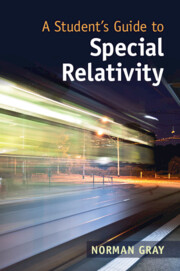Refine listing
Actions for selected content:
16950 results
Aims
-
- Book:
- A Student's Guide to Special Relativity
- Published online:
- 26 January 2022
- Print publication:
- 03 February 2022, pp xvi-xvi
-
- Chapter
- Export citation
Epigraph
-
- Book:
- A Student's Guide to Special Relativity
- Published online:
- 26 January 2022
- Print publication:
- 03 February 2022, pp v-vi
-
- Chapter
- Export citation
References
-
- Book:
- A Student's Guide to Special Relativity
- Published online:
- 26 January 2022
- Print publication:
- 03 February 2022, pp 204-210
-
- Chapter
- Export citation
2 - The Axioms
-
- Book:
- A Student's Guide to Special Relativity
- Published online:
- 26 January 2022
- Print publication:
- 03 February 2022, pp 18-31
-
- Chapter
- Export citation
How to Do Calculations: a Recipe
-
- Book:
- A Student's Guide to Special Relativity
- Published online:
- 26 January 2022
- Print publication:
- 03 February 2022, pp 200-204
-
- Chapter
- Export citation

A Student's Guide to Special Relativity
-
- Published online:
- 26 January 2022
- Print publication:
- 03 February 2022
-
- Textbook
- Export citation
Part II - General Relativity
-
- Book:
- Sidney Coleman's Lectures on Relativity
- Published online:
- 23 December 2021
- Print publication:
- 13 January 2022, pp 93-94
-
- Chapter
- Export citation
Appendix A - Compendium of Formulas
-
- Book:
- Sidney Coleman's Lectures on Relativity
- Published online:
- 23 December 2021
- Print publication:
- 13 January 2022, pp 223-229
-
- Chapter
- Export citation
Afterword
-
- Book:
- Sidney Coleman's Lectures on Relativity
- Published online:
- 23 December 2021
- Print publication:
- 13 January 2022, pp 220-222
-
- Chapter
- Export citation
3 - Relativistic Electrodynamics
- from Part I - Special Relativity
-
- Book:
- Sidney Coleman's Lectures on Relativity
- Published online:
- 23 December 2021
- Print publication:
- 13 January 2022, pp 63-92
-
- Chapter
- Export citation
Preface
-
- Book:
- Sidney Coleman's Lectures on Relativity
- Published online:
- 23 December 2021
- Print publication:
- 13 January 2022, pp ix-x
-
- Chapter
- Export citation
6 - Gravity
- from Part II - General Relativity
-
- Book:
- Sidney Coleman's Lectures on Relativity
- Published online:
- 23 December 2021
- Print publication:
- 13 January 2022, pp 132-161
-
- Chapter
- Export citation
5 - Differential Geometry
- from Part II - General Relativity
-
- Book:
- Sidney Coleman's Lectures on Relativity
- Published online:
- 23 December 2021
- Print publication:
- 13 January 2022, pp 100-131
-
- Chapter
- Export citation
7 - The Schwarzschild Solution
- from Part II - General Relativity
-
- Book:
- Sidney Coleman's Lectures on Relativity
- Published online:
- 23 December 2021
- Print publication:
- 13 January 2022, pp 162-199
-
- Chapter
- Export citation
Index
-
- Book:
- Sidney Coleman's Lectures on Relativity
- Published online:
- 23 December 2021
- Print publication:
- 13 January 2022, pp 234-250
-
- Chapter
- Export citation
Contents
-
- Book:
- Sidney Coleman's Lectures on Relativity
- Published online:
- 23 December 2021
- Print publication:
- 13 January 2022, pp v-viii
-
- Chapter
- Export citation
1 - The Geometry of Special Relativity
- from Part I - Special Relativity
-
- Book:
- Sidney Coleman's Lectures on Relativity
- Published online:
- 23 December 2021
- Print publication:
- 13 January 2022, pp 3-33
-
- Chapter
- Export citation
2 - Relativistic Mechanics
- from Part I - Special Relativity
-
- Book:
- Sidney Coleman's Lectures on Relativity
- Published online:
- 23 December 2021
- Print publication:
- 13 January 2022, pp 34-62
-
- Chapter
- Export citation
Appendix B - Final Exams
-
- Book:
- Sidney Coleman's Lectures on Relativity
- Published online:
- 23 December 2021
- Print publication:
- 13 January 2022, pp 230-233
-
- Chapter
- Export citation
Part I - Special Relativity
-
- Book:
- Sidney Coleman's Lectures on Relativity
- Published online:
- 23 December 2021
- Print publication:
- 13 January 2022, pp 1-2
-
- Chapter
- Export citation
